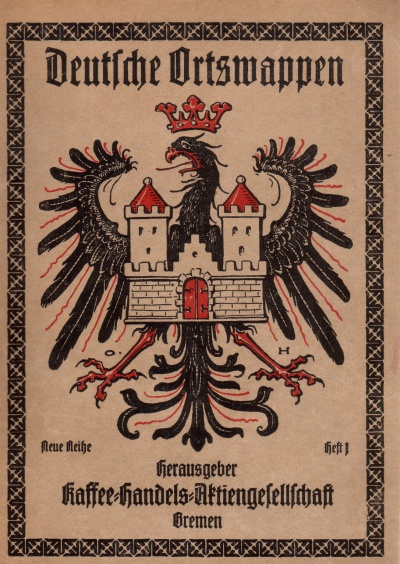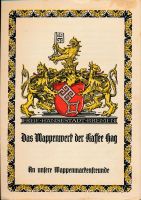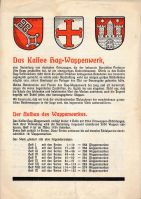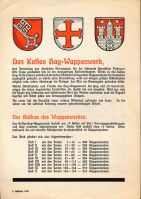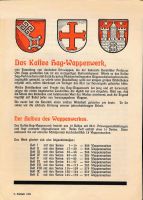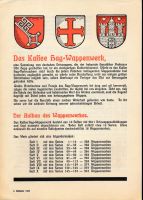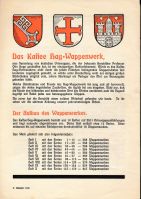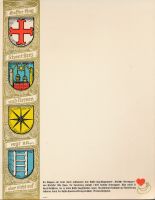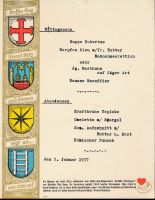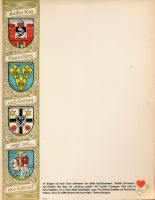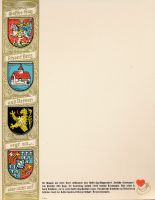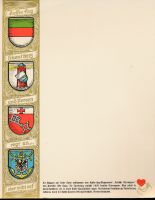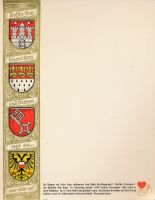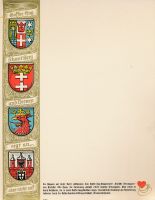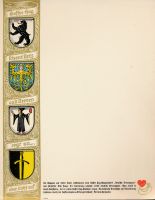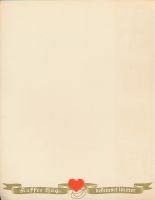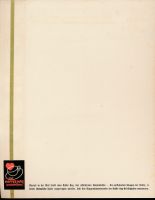Kaffee Hag albums : Deutsche Ortswappen Neue Reihe
Album information :
- Issued by : Kaffee Hag, Bremen, Germany
- Date of issue : 1927-1939
- Number of stamps/cards : 2811 (officially)
- Image variants : many
- Author : Otto Hupp
The albums
The new (second) series was published as Deutsche Ortswappen (Neue Reihe) between 1927 and 1938. There are several differences as compared with the old series issued between 1913-1918.
The albums were issued as loose sheets, which could be bound in either 10 small albums, or in four large albums. Each page contained 9 arms. The content of the 10 albums was described, still people often filled the albums at random or by State, which means that each album may contain different pages.
The four large albums were not numbered and could be used at will.
The arms were published by province/State, but the images of the different provinces were not issued at the same time, some parts were issued years after the first half of the series.
Like in the old series the back of the arms contained the description and some advertising. The stamps were issued in sheets of 18.
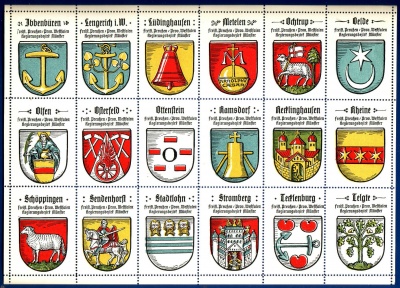
|
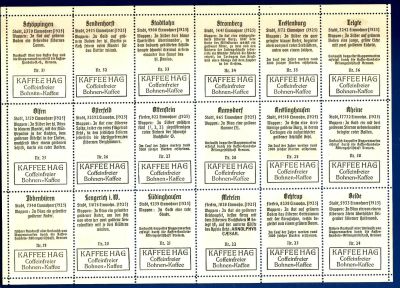
|
There are many variations in the new series known. As the images and the sheets often needed to be reprinted, small corrections were made and mistakes were corrected. There are at least 75 different images known, which are not listed in the Additions and Corrections section. Besides this, there are hundreds of texts variations known (both in albums and on the stamps), such as changes in the number of inhabitants, changed descriptions of the arms, changed status (town, city, village) and many more.
An example of a variation is Neumünster
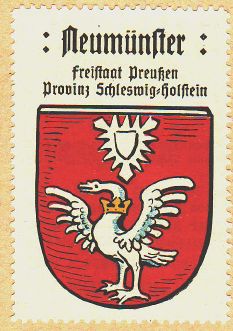
|
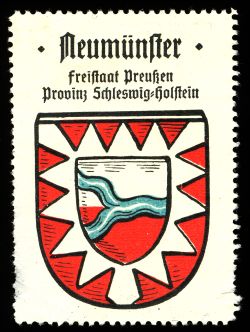
|
Other variations are misprints:
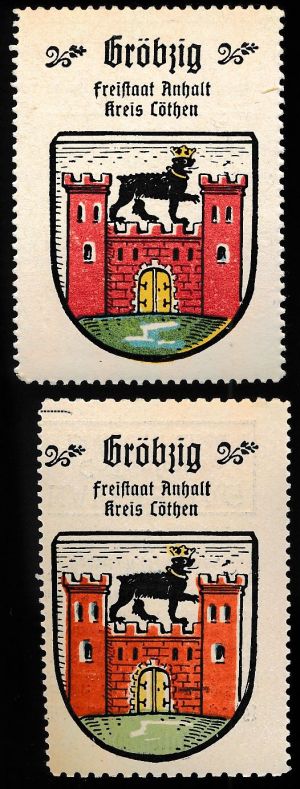 narrow cut |
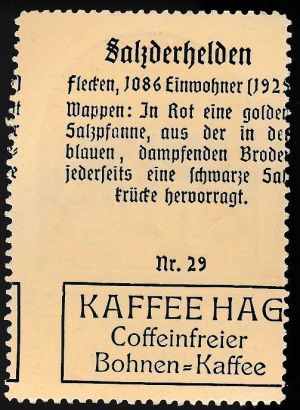 text cut |
Contents
The arms of the following States and provinces were issued :
- Anhalt (free-state) : 22 arms with space for additions.
- Baden (free-state) : 135 arms
- Bayern :
- District Mittelfranken : 84 arms
- District Niederbayern : 78 arms
- District Oberbayern : 81 arms
- District Oberfranken : 89 arms
- District Oberpfalz : 93 arms
- District Rheinpfalz : 54 arms
- District Schwaben : 76 arms
- District Unterfranken : 72 arms
- Braunschweig (free-state) : 16 arms
- Bremen : 3 arms, published on the pages after Hannover – Stade and numbers 1-3 in that series; same 3 arms, published as numbers 1-3 in the Hanse pages
- Hamburg : 4 arms, published and numbered after Lippe/Schaumburg-Lippe; 4 arms (1 different) published as numbers 4-8 in the Hanse pages
- Hessen :
- District Oberhessen : 36 arms (plus one addition, published after Rheinhessen)
- District Rheinhessen : 21 arms (plus one addition)
- District Starkenburg : 43 arms (plus one addition, published after Rheinhessen)
- Lippe : 11 arms, published as part of Lippe/Schaumburg-Lippe
- Lübeck : 2 arms, published and numbered after Braunschweig; The same 2 arms published as numbers 8 and 9 in the Hanse pages
- Mecklenburg-Schwerin : 44 arms
- Mecklenburg-Strelitz : 9 arms
- Oldenburg : 18 arms
- Preussen (kingdom)
- Berlin : 36 arms
- Province Brandenburg
- district Frankfurt an der Oder : 68 arms
- district Potsdam : 79 arms
- Province Grenzmark Posen-Westpreussen : 26 arms
- Province Hannover
- district Aurich : 8 arms
- district Hannover : 36 arms
- district Hildesheim : 36 arms
- district Lüneburg : 24 arms
- district Osnabrück : 16 arms
- district Stade : 15 arms
- Province Hessen-Nassau
- district Kassel (partly published as Cassel) : 78 arms
- district Wiesbaden : 53 arms
- Province Hohenzollernsche Lande (also published as Rheinprovinz, district Sigmaringen) : 9 arms
- Province Niederschlesien
- district Breslau : 60 arms (also partly published as Province Schlesien)
- district Liegnitz : 63 arms (plus one addition after Obeschlesien-Oppeln)
- Province Oberschlesien
- district Oppeln : 44 arms (of which one as addition)
- Province Ostpreussen
- Province Pommern
- Province Rheinprovinz
- district Aachen : 18 arms
- district Düsseldorf : 72 arms
- district Koblenz : 44 arms (of which one as addition)
- district Köln : 18 arms
- district Trier : 24 arms (of which one as addition)
- Province Sachsen
- district Erfurt : 30 arms
- district Magdeburg : 54 arms
- district Merseburg : 77 (plus one published as correction at the end)
- Province Schleswig-Holstein : 51 arms (of which four as additions)
- Province Westfalen
- district Arnsberg : 64 arms (of which one as addition after Westfalen – Münster)
- district Minden : 44 arms
- district Münster : 43 arms (of which one as addition)
- Saargebiet : 9 arms
- Sachsen (free-state)
- district Bautzen : 18 arms
- district Chemnitz : 31 arms
- district Dresden : 36 arms (published as Kreishauptmannschaft Dresden and Kreis Dresden)
- district Leipzig : 36 arms
- district Zwickau : 31 arms (of which two as additions)
- Schaumburg-Lippe : 3 arms, published as part of Lippe/Schaumburg-Lippe
- Thüringen : 101 arms
- Württemberg
- district Donaukreis : 36 arms
- district Jagtkreis : 35 arms (of which 3 as additions)
- district Neckarkreis : 40 arms
- district Schwarzwaldkreis : 39 (of which 3 additions after the Neckarkreis)
- Additions and Corrections : 44 arms, numbered in sequence of their province/district
Images issued
For an overview of all images (over 5000) issued see here.
Advertising and promoting
As in the other countries Kaffee Hag actively promoted the albums in many ways. Of course the company issued general leaflets on the albums, but also lots of different ways of advertising were used. Several examples are shown below.
Leaflets etc
During the years the company issued a number of small leaflets with information on the background of the series, the progress of the issues, how to order the stamps and, in the later issues, also information on the international albums.
These brochures are not dated prior to 1935. The approximate date can be deducted based on the texts in the brochures like: 'album 7 will be issued in June 1932', indicating that the brochure is probably from early 1932.
The texts in the three different styled leaflets is largely identical. Only updates in the albums are different and for example 1934-1 differs from 1934-2 in that only stamps and not coffee could be ordered on the coupons. The 1336-1, -2 and 1937-1 are identical, except for the date on the front page.
I am aware of the following leaflets (click to open a pdf of the leaflet; opens in this tab, to open in a new tab, use the right mouse button):
When the albums were complete, small leaflets with an overview on how to order the albums were issued. I am aware of three of those, they are not dated, but probably 1937 as the albums were completed in 1937, 1938 with a new font and 1939 with the same new font, but describing album 11 with the arms of the Ostmark (=Austria after the Anschluss of 1938).
(click to open a pdf of the leaflet; opens in this tab, to open in a new tab, use the right mouse button):
Specifically children were targeted, as they were more likely to collect the stamps as adults. For this small cards were distributed with the coffee. The front design is the same as for the albums, the second and third page describe the albums and target specifically children 'Liebe junge Freunde' or 'Dear young friends'. The fourth page showed a stamp from the albums as an example. Striking here is that for these cards several stamps were used from the Pfalz series, that were never issued in the albums itself ! These small booklets (Klappkarten) thus were used to get rid of the surplus of unused images.
Menucards
Menucards were distributed to restaurants that served the HAG Coffee. The company did so already earlier, but in the 1930s started to issue a design with arms from the albums. A series of 14 numbered cards was printed and a special issue for the 1936 Olympic Games was issued later. As these were for short-time use, not many used ones have survived. The company also issued this type of cards in France and Switzerland, but, as far as I know, not in other countries were the albums have been issued.
